The Age of Streamliners: The Union Pacific and the City of Los Angeles
In the archives of American railroading history, few stories are as captivating as the era of streamlined passenger trains. During the early to mid-20th century, railroads embarked on a bold endeavor to modernize and revolutionize passenger travel. At the forefront of this movement was the Union Pacific Railroad, and one of its most iconic contributions to the age of streamliners was the "City of Los Angeles." In this article, we will delve into the Union Pacific's push for streamlined passenger trains, explore the legacy of the "City of Los Angeles," and examine the factors that led to the decline of passenger rail in the mid-20th century.
The Union Pacific's Push for Streamlined Passenger Trains
The 1930s marked a period of immense innovation in the realm of American railroads. Faced with competition from automobiles and airplanes, railroads sought to reinvigorate passenger travel by offering speed, luxury, and style. The Union Pacific, under the visionary leadership of its president, William Jeffers, emerged as a pioneer in this endeavor.
Jeffers recognized that to compete effectively, the Union Pacific needed a fleet of modern, streamlined trains. Streamlining was more than just an aesthetic choice; it had practical benefits, such as reducing wind resistance, which allowed trains to travel faster and more efficiently. The Union Pacific collaborated with industrial designer Raymond Loewy to create sleek, futuristic designs that would become synonymous with the era.
In 1934, the Union Pacific unveiled the "M-10000," a diesel-electric streamliner that captured the public's imagination. This was just the beginning, as the railroad embarked on a series of ambitious projects to streamline its entire passenger fleet.
The "City of Los Angeles" and Other Famous UP Streamliners
One of the most iconic streamliners to emerge from the Union Pacific's efforts was the "City of Los Angeles." This luxurious train made its inaugural run in May 1936 and quickly became the epitome of elegance and modernity in rail travel. Its cars featured Art Deco-inspired interiors, air conditioning, and a distinctive two-tone gray color scheme.
The "City of Los Angeles" wasn't the only famous streamliner in the Union Pacific's fleet. The "City of San Francisco," the "City of Denver," and the "City of Portland" were among the other notable trains that crisscrossed the western United States, connecting major cities and offering unparalleled comfort and speed.
These streamliners represented not only a leap forward in technology but also a new era in luxury travel. Passengers could enjoy gourmet dining, observation cars with panoramic views, and spacious bedrooms. It was a far cry from the cramped, slow, and often uncomfortable trains of the past.
The Decline of Passenger Rail in the Mid-20th Century
Despite the initial success and popularity of streamliners like the "City of Los Angeles," the mid-20th century brought about significant challenges for passenger rail travel. Several factors contributed to the decline of this once-dominant mode of transportation.
1. Competition from Other Modes: The rise of the automobile and the affordability of air travel posed serious competition to passenger railroads. Americans increasingly chose the convenience and speed of cars and planes over train journeys.
2. Government Regulations: Regulatory changes, such as the creation of Amtrak in 1971, brought about reforms and cost-sharing arrangements that aimed to rescue the struggling passenger rail industry. However, these efforts were not always successful, and passenger rail continued to face financial challenges.
3. Shift in Travel Preferences: Changing consumer preferences and lifestyles led to a decline in the demand for long-distance train travel. People became more focused on individualized, point-to-point transportation.
4. Economic Pressures: Economic downturns and rising operational costs further strained the financial viability of passenger rail service. Many railroads, including the Union Pacific, began to prioritize their freight operations over passenger services.
In the face of these challenges, iconic streamliners like the "City of Los Angeles" became relics of a bygone era. However, their legacy lives on in the annals of American railroad history, reminding us of a time when trains were not just a mode of transportation but a symbol of progress, luxury, and innovation.
In conclusion, the Union Pacific's push for streamlined passenger trains during the mid-20th century, epitomized by the "City of Los Angeles," represents a remarkable chapter in American transportation history. While the decline of passenger rail in the face of evolving travel preferences and economic pressures was inevitable, the legacy of these iconic streamliners continues to captivate and inspire rail enthusiasts and historians alike. The age of streamliners may have passed, but the memories of their elegance and sophistication still endure in the hearts and minds of those who appreciate the romance of the rails.
Recent Posts
-
Prototype Spotlight: GE ES44AC — Modeling a Modern Freight Workhorse
Prototype Spotlight: GE ES44AC — Modeling a Modern Freight Workhorse Published 2025-09-29• 8–10 min
-
How to Build a Realistic Freight Yard: Flow, Trackwork, and Car Management
How to Build a Realistic Freight Yard: Flow, Trackwork, and Car Management Published 2025-09-25 • 8
-
Scenery Basics: From Foam to Foliage — A Quick, Budget-Friendly Guide | Midwest Model Railroad
Modeling Tutorial Scenery Basics: From Foam to Foliage Published 2025-09-23 · 7–9 minute read Li




